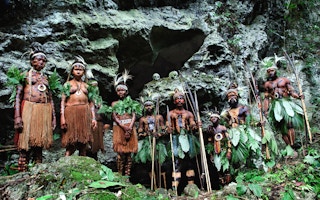Governments in forested countries should look at strengthening the rights of their local communities as a key strategy to reducing billions of tonnes of carbon emissions, said a new report released on Thursday.
To continue reading, subscribe to Eco‑Business.
There's something for everyone. We offer a range of subscription plans.
- Access our stories and receive our Insights Weekly newsletter with the free EB Member plan.
- Unlock unlimited access to our content and archive with EB Circle.
- Publish your content with EB Premium.
Published by the World Resources Institute (WRI) and Rights and Resources Initiative (RRI), the study provides evidence – the most comprehensive to date - that links government protection and legal recognition of community forest rights with reductions in greenhouse gas emissions.
The authors, who used high-resolution mapping data to analyse 14 heavily-forested countries including Brazil, Indonesia and Colombia, found that when governments enhanced and enforced forest rights, communities were more successful at reducing deforestation.
In fact, deforestation rates inside community forests were dramatically lower than in forests outside those areas. For example, in a part of the Mexican Yucatán, it is 350 times lower; and in the Brazilian Amazon, it is 11 times lower.
The report, called “Securing Rights, Combating Climate Change: How Strengthening Community Forest Rights Mitigates Climate Change”, noted that indigenous peoples across the world have government-recognized rights to forests containing 37.7 billion tonnes of carbon – which is about 29 times the annual emissions from all passenger vehicles in the world.
Deforestation and other land uses make up 11 per cent of global carbon dioxide emissions.
Global research organization WRI president and chief executive, Andrew Steer, said: “This golden opportunity to address climate change is staring us right in the face. With at least 37 billion tonnes of carbon safely stored in community forests around the world, strengthening community rights is good for the climate and good for people.”
“Every head of government, minister and climate negotiator should pay attention to this important, if often overlooked strategy to address climate change. It’s an approach to climate action that should be right up there with REDD+ or increasing energy efficiency,” he added.
REDD+ is a United Nations initiative that offers financial incentives to developing countries to reduce carbon emissions through protecting and restoring forests.
The report also offers cautionary tales on the fate of forests when governments undermine community forest rights. Government allocations of indigenous lands to mining, oil, and natural gas concessions are a major cause of these devastating deforestation levels, it said.
In Indonesia, for example, out of at least 42 million hectares of community forests, only 1 million hectares are legally recognized by the government. It routinely allocates indigenous community forests for oil palm concessions, industrial timber plantations for pulp and paper, and other conflicting land uses.
Deforestation is the country’s largest source of carbon emissions and its forestry management is inseparable from its climate change policies. The nation has set an emissions reduction target of 26 per cent from projected 2020 levels.
Report author Caleb Stevens told Eco-Business that despite the urgency to address the situation, the Indonesian government has delayed action on recognizing communities’ legal rights over their forest homes.
“
Every head of government, minister and climate negotiator should pay attention to this important, if often overlooked strategy to address climate change. It’s an approach to climate action that should be right up there with REDD+ or increasing energy efficiency.
Andrew Steer, WRI president and chief executive
He said the government should implement the 2013 Constitutional Court ruling which for the first time recognizes community ownership over their forests. Specifically, it ruled that community forest could no longer be classified as state forest.
This is a historic breakthrough as most of Indonesia’s forests have been claimed by the government since the 1967 Forestry Law which prevented millions of forest peoples from having legal rights to their forest homes.
By mapping community forests and identifying 42 million hectares of community forests, Indonesian NGOs such as AMAN and JKPP are trying to help the government implement the new law—facilitating the process as it were by laying the groundwork, he noted.
“If these 42 million hectares are legally recognized and protected, then about 44 per cent of Indonesia’s forests would be legally recognized community forest. This would turn Indonesia from a laggard on this issue to a leader, on par with more progressive countries like Bolivia and Nepal,” he said.
The report also made five key recommendations that its authors say will significantly reduce global carbon emission from the loss of forests:
- Provide communities with legal recognition of rights to their forest;
- Enforce community forest rights such as mapping boundaries and expelling trespassers;
- Provide technical assistance and training to forest communities to improve sustainable forest use and market access;
- Engage forest communities in decision-making on investments affecting their forest; and
- Compensate communities for the climate and other benefits provided by their forest.
Andy White, coordinator of RRI, a global coalition of organisations dedicated to empowering local and indigenous communities in forest management, said: “No one has a stronger interest in the health of forests than the communities that depend on them for their livelihoods and culture.”
“Research has shown time and time again that clear and secure property rights for indigenous peoples and local communities have greatly boosted the capacity of countries to achieve national-level forest protection and restoration.
It’s tragic that this has not yet been fully adopted as a central climate change mitigation strategy. For us to get serious about curbing climate change, we have to get serious about respecting the rights of local communities to the lands they live and depend on,” he added.










